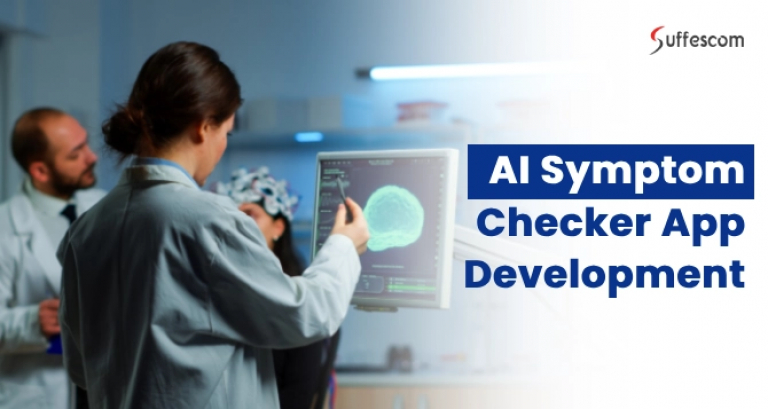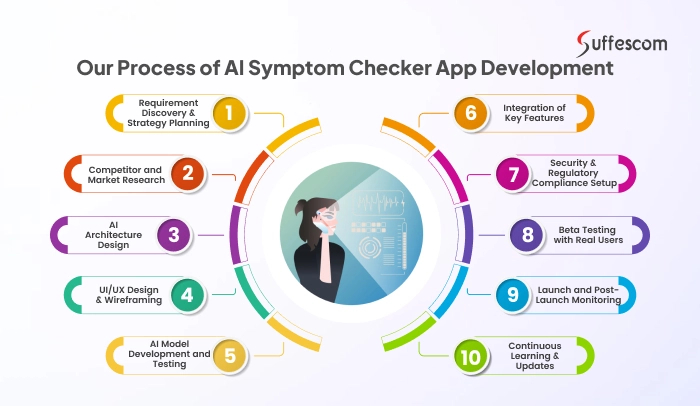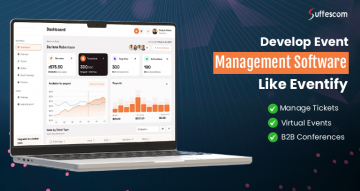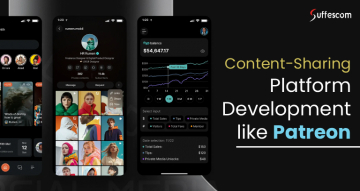AI Symptom Checker App Development | Build Symptom Checker App

Most of us have done it. You feel a strange headache, type your symptoms into Google, and suddenly you’re convinced you have something serious. The internet is full of scattered information, and that’s where AI symptom checker apps step in.
These apps are designed to guide users toward possible conditions, offer early health insights, and suggest whether it’s time to see a doctor. No confusion, no random search rabbit holes just structured, data-backed answers.
More and more people are now using AI symptom checkers to understand their health and decide when to visit a doctor. In 2024, 48.1% of AI symptom checker users globally were from the United States, indicating a significant demand in the U.S. market.
46% of people used AI symptom checkers to check mental health issues like anxiety and depression. 41% looked up problems like skin conditions, digestion issues, and headaches, especially eczema and acid reflux.
If you’re thinking about building one of these apps, let’s break down what they are, how they work, the features users actually want, and the steps to develop a reliable AI symptom checker app.
What are AI Symptom Checker Apps?
It is not hard to understand what these apps do. As the term itself suggests, AI symptom checker applications utilize artificial intelligence to identify health symptoms. These applications serve as digital health tools that help users understand what may be causing their health symptoms.
These apps ask simple questions and suggest possible conditions or advice based on the user’s answers. They are becoming increasingly popular for offering fast, accessible, and private health insights.
Simplest Understanding of How AI Symptom Checker Apps Work
An AI symptom checker uses artificial intelligence to analyze the information users provide. It compares this data with a huge medical database. Then, it gives suggestions or points to likely causes, just like a virtual doctor would during an initial check-up.
Think of it like a GPS for your health. You tell it where you feel discomfort (symptoms), and it maps out possible destinations (conditions or concerns). It doesn't replace a doctor but helps guide you in the right direction.
These apps are designed with machine learning algorithms trained on real-world medical cases. They can understand how symptoms relate to specific illnesses. Over time, they learn and improve their accuracy.
What's Next?
In AI symptom checker app development, the goal is to build smart, user-friendly applications that provide prompt results and reliable suggestions. The best tools adhere to healthcare guidelines and incorporate security and privacy features.
If you want to develop a symptom tracker app, start by defining the user's needs. Use expert-verified medical datasets. Work with healthcare professionals and an AI development company to ensure the app is safe, effective, and compliant with healthcare regulations.
However, before we understand how to create an AI symptom tracker app, it is essential to know what its key features are.
Build Your Own AI-Based Symptom Checker App Today
Build your own AI-based symptom tracker app today with expert guidance, cutting-edge tech, and full regulatory compliance.
Essential Features of AI Symptom Tracker Applications
Our AI symptom tracker software is equipped with the necessary functions. Let's explore them.
1. Symptom Input Interface
Users can manually enter symptoms or select from a list. The app may use voice recognition for added convenience. A clean interface ensures easy data input, even for non-tech-savvy users.
2. AI-Enabled Symptom Analysis
The app uses AI/ML models to compare symptoms with medical databases. It identifies patterns and offers possible conditions based on probability. It helps users understand health issues early, without relying on medical jargon.
3. AI Integration
From AI in physical therapy to AI therapy apps for mental health, our applications include scalable AI integration services. Such a provision increases the overall functionality of the software.
4. Natural Language Processing (NLP)
NLP allows users to describe symptoms in everyday language. The system interprets free-text inputs, such as "I feel dizzy and tired." This makes interaction feel natural and boosts user engagement.
5. Real-Time Suggestions and Pre-Diagnosis
After analysis, the app provides instant suggestions. It might recommend resting, visiting a doctor, or tracking symptoms further. This ensures timely action based on urgency.
6. User’s Health Profile
The app collects user health history, allergies, medications, and age. Personalization improves result accuracy and avoids generic advice. It's especially valuable for users with chronic conditions.
7. Symptom Tracking Logs
Users can track symptoms over time. The feature helps detect trends or recurring issues. This data can be shared with doctors during appointments.
8. Telemedicine Integration
The AI symptom tracker app can connect users to certified doctors. This feature enables users to consult a professional if needed. It bridges the gap between self-assessment and real care.
9. Multilingual Support
AI systems can process multiple languages, enabling global accessibility. This ensures the app can serve diverse populations. Multilingual features improve inclusivity in digital healthcare.
10. Security and Compliance Features
The app must comply with HIPAA, GDPR, and other healthcare regulations. Data encryption, consent-based sharing, and user anonymity build trust. It ensures user safety while handling sensitive health data.
11. Feedback and Continuous Learning Module
Users can give feedback on the accuracy of suggestions. The AI learns from real-world inputs and improves over time. This helps refine performance for long-term effectiveness.
Our Process of AI Symptom Checker App Development
Let's understand what goes behind our process of creating AI symptom tracking applications that beat the competition and deliver desired results.

1. Requirement Discovery & Strategy Planning
We begin by understanding the client's business goals, specific requirements, and target users. Requirement analysis and planning help define the app's purpose and outline essential features.
It saves time and budget by aligning the product with real needs and AI MVP development practices. Skipping this stage may lead to feature overload or missed functionalities, thus increasing costs later.
2. Competitor and Market Research
We evaluate existing AI symptom apps, identify their potential and scope of improvements, and explore current trends. This helps differentiate your product and identify opportunities.
Understanding competitors and market research helps build a unique selling proposition (USP) that meets user demands. Inadequate market research assures against the risk of launching an outdated or underperforming app.
3. AI Architecture Design
We plan the AI model architecture and define various verified and diverse medical datasets to train it with higher accuracy. An effective AI architecture and data sourcing strategy helps tailor the app for diverse user bases, especially when combined with region-specific medical datasets and language support.
A practical design enhances reliance on medical data, and any inefficiencies result in weak AI performance. It is highly crucial to focus on design to develop a symptom tracker app.
4. UI/UX Design & Wireframing
We begin with crafting intuitive designs and wireframes. This step defines how the app will look and how users will interact with it. A clean interface enhances user trust and engagement. It is helpful for patients of all age groups, especially those with limited tech experience.
A simple chatbot-driven symptom entry screen reduces drop-off rates in elderly users. Skipping this step leads to user confusion, negative reviews, and high abandonment rates, ultimately resulting in redesign costs later on.
5. AI Model Development and Testing
This step involves building the AI engine that powers symptom recognition, risk prediction, and recommendations. It ensures accurate results and better health outcomes for users.
At the testing level, this stage helps users determine whether they need to consult a doctor or manage their symptoms at home. An untrained or poorly tested model may give wrong suggestions, risking user safety and brand trust.
6. Integration of Key Features
We integrate core features like multi-language support, chatbots, health logs, reminders, and teleconsultation modules in our AI-based symptom checker app. These features deliver a seamless experience and enhance app usability.
Patients get not just symptom checks but also care guidance and follow-ups. Using these features, the user can track daily symptoms, schedule a doctor's consultation, and share logs with their physician. Missing key features leads to unsatisfactory experiences and user drop-offs.
7. Security & Regulatory Compliance Setup
We implement security measures and ensure compliance with regulations like HIPAA and GDPR. Such compliance fosters trust and ensures data security, which is essential for healthcare apps.
Security and regulatory compliance setups ensure that sensitive patient data remains encrypted and protected. Security breaches or fines due to non-compliance can cause legal trouble and financial loss.
8. Beta Testing with Real Users
Before launch, we conduct live testing with real users to gather feedback and make improvements. It helps identify usability issues, bugs, or misinterpretations in AI recommendations.
Beta Testing helps optimize performance across devices and user types. Skipping testing may lead to post-launch failures, reputational damage, and costly fixes.
9. Launch and Post-Launch Monitoring
Once launched, we monitor usage, performance, and user feedback in real time. By doing so, we ensure smooth performance and allow for quick bug fixes and feature rollouts. This step helps detect any technical glitches early.
The team notices a crash issue on various devices and patches it quickly. Ignoring monitoring lets minor issues spiral into serious retention problems.
10. Continuous Learning & Updates
We continuously update the AI model using new health data and user feedback to ensure the app remains accurate and relevant as disease patterns evolve. Ensuring continuous learning and updates tracks seasonal illnesses or rare outbreaks.
Outdated models reduce accuracy, user trust, and your competitive edge. That's why continuous learning and updates are essential for an AI-based symptom checker app.
Benefits of Building an AI Symptom Checker App
1. Enhances Patient Involvement and Self-care
These applications promote individuals to become more engaged in learning about their health. Monitoring symptoms and receiving immediate advice help users feel more empowered and reduce their chances of neglecting early symptom warning signs.
2. Reduces Unnecessary Hospital Visits
Not all headaches or stomachaches lead to the ER. AI symptom checkers can be used to sift through minor and serious problems, saving patients time and pushing hospitals to their limits.
3. Offers 24/7 Accessibility
An AI symptom checker is always available, as opposed to clinics that have fixed schedules. At night time, on weekends or when traveling users can check their symptoms anytime they require reassurance.
4. Strengthens Trust with Compliance and Security
By adhering to HIPAA, GDPR, and other standards in medical apps, the user can be confident that their data is secure. Effective compliance controls create confidence and broaden adoption.
Helps Health Professionals Simplify the Triage
These apps can be used by nurses and doctors as a pre-filter. They soon understand what cases should be considered urgent, which can be postponed, and which are capable of being managed at home, and the flow of patients becomes smoother.
Who Can Get Benefit From These Apps?
Healthcare Startups
AI symptom checker apps can be launched independently as a standalone app or within a more comprehensive health platform, which facilitates opportunities in preventive healthcare and digital health.
Hospitals and Clinics
The purpose of these apps in hospitals is to facilitate the management of patients intake, to minimize waiting time and more effectively prioritize cases before appointment.
Telemedicine Platforms
Symptom checkers serve as a natural point of entry into services of telemedicine. They refer patients to virtual consultations where the service is needed, increasing service adoption.
Insurance Providers
To insurers, the apps can reduce costs of claims by promoting preventive care and decreasing the number of inappropriate visits to hospitals. They also assist in the evaluation of risk profile.
Public Health Agencies
Governments and other agencies can use such apps at scale to track community health trends, early identify outbreaks, and disseminate credible medical guidance.
Accelerate Your AI Symptom Tracker App Development Now
Develop a market-leading AI-enabled symptom tracker with our expert team, proven process, and healthcare-compliant solutions.
Get the Best AI Symptom Tracker App Development with Suffescom
Developing a reliable AI symptom checker takes more than just code; it takes care, clarity, and commitment. Every step we've outlined plays a vital role in creating a product that genuinely helps people and builds trust.
Being a reliable AI healthcare software development company, we understand what it takes to turn your vision into a working, effective digital health product. With proven experience in AI symptom tracker app development, we help healthcare innovators launch intelligent apps that are user-friendly, secure, and future-ready.
Whether you're building for patients, clinics, or public health, our team is ready to support your mission. Let’s create something that improves lives, together.
FAQs
1. What is an AI symptom checker app?
An AI symptom checker app uses artificial intelligence to help users identify health-related symptoms.
2. How to create an AI symptom tracker app?
The process of AI symptom checker app development starts with requirement analysis & strategy, followed by competitor and market research, AI architecture design, UI/UX design & wireframing, AI model development and testing, key features' integration, security & regulatory compliance setup, beta testing with real users, launch and post-launch monitoring, and continuous learning & updates.
3. How does an AI symptom tracker app work?
An AI symptom tracker app uses AI/ML algorithms to analyze the symptoms. It then compares them against medical databases to suggest possible conditions.
4. What are the essential features of an AI symptom tracker app?
An AI symptom tracking application must include features such as a symptom input interface, AI-enabled symptom analysis, Natural Language Processing (NLP), real-time suggestions, pre-diagnosis, user's health profile, symptom tracking logs, telemedicine integration, multilingual support, security and compliance features, and a feedback and continuous learning module.
5. Is it safe to use AI symptom-tracking software?
Yes, it is entirely safe to use an AI symptom checker application as long as it adheres to necessary medical regulations, such as HIPAA or GDPR. It is wise to choose a reliable healthcare app development company for trustworthy AI-based symptom trackers.
6. Who can benefit from building an AI medical symptom checker?
Healthcare startups, hospitals, telemedicine platforms, insurance companies, and public health agencies can all benefit from deploying an AI medical diagnosis app to streamline healthcare.
7. Can an AI symptom checker diagnose mental health issues?
Yes, many apps now include mental health symptom tracking, but results should always be reviewed by professionals.
8. What datasets are used to train AI symptom checkers?
They’re trained on verified medical databases, anonymized patient records, and real-world clinical cases.







